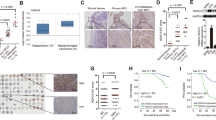Abstract
Inhibition of histone deacetylases (HDACs) is a promising new approach to the treatment of lung cancer therapy. The relation between HDAC3 expression and the clinicopathological characteristics of lung cancer is not well understood, however. We therefore addressed this issue in patients with adenocarcinoma of the lung. We used semi-quantitative real-time reverse transcription polymerase chain reaction and immunohistochemical analysis to assess expression of HDAC3 in tumor samples from 94 patients with adenocarcinoma of the lung. We then correlated levels of HDAC3 expression with known clinicopathological factors. The 5-year disease-free survival (5-DFS) rate among patients expressing high levels of HDAC3 was significantly poorer than among those expressing lower levels (P = 0.005; log-rank test). Multivariate Cox proportional hazard analyses revealed male (hazard ratio, 3.88; 95% CI, 1.70-9.39; P = 0.001), nodal metastasis N1 (hazard ratio, 6.39; 95% CI, 1.54-22.7; P = 0.013), N2 (hazard ratio, 6.36; 95% CI, 1.55-33.6; P = 0.009), and HDAC3 (hazard ratio, 3.06; 95% CI, 1.07-7.55; P = 0.037) to be independent factors affecting the 5-DFS rate. Strong tumoral expression of HDAC3 is an independent predictor of a poor prognosis in patients with adenocarcinoma of the lung.



Similar content being viewed by others
References
Karagianni P, Wong J. HDAC3: taking the SMRT-N-CoRrect road to repression. Oncogene. 2007;26:5439–49.
Weichert W, Röske A, Niesporek S, et al. Class I histone deacetylase expression has independent prognostic impact in human colorectal cancer: specific role of class I histone deacetylases in vitro and in vivo. Clin Cancer Res. 2008;14:x1669–77.
Krusche CA, Wülfing P, Kersting C, et al. Histone deacetylase-1 and -3 protein expression in human breast cancer: a tissue microarray analysis. Breast Cancer Res Treat. 2005;90:15–23.
Osada H, Tatematsu Y, Saito H, Yatabe Y, Mitsudomi T, Takahashi T. Reduced expression of class II histone deacetylase genes is associated with poor prognosis in lung cancer patients. Int J Cancer. 2004;112:26–32.
Sasaki H, Moriyama S, Nakashima Y, et al. Histone deacetylase 1 mRNA expression in lung cancer. Lung Cancer. 2004;46:171–8.
Tan J, Cang S, Ma Y, Petrillo RL, Liu D. Novel histone deacetylase inhibitors in clinical trials as anti-cancer agents. J Hematol Oncol. 2010;3:5.
Siegel D, Hussein M, Belani C, et al. Vorinostat in solid and hematologic malignancies. Journal of Hematology & Oncology. 2009;2:31.
Cang S, Ma Y, Liu D. New clinical developments in histone deacetylase inhibitors for epigenetic therapy of cancer. Journal of Hematology & Oncology. 2009;2:22.
Cress WD, Seto E. Histone deacetylases, transcriptional control, and cancer. J Cell Physiol. 2000;184:1–16.
Ramalingam SS, Maitland ML, Frankel P, et al. (2010) Carboplatin and paclitaxel in combination with either vorinostat or placebo for first-line therapy of advanced non-small-cell lung cancer. J Clin Oncol (in press).
Ramalingam SS, Parise RA, Ramanathan RK, et al. Phase I and pharmacokinetic study of vorinostat, a histone deacetylase inhibitor, in combination with carboplatin and paclitaxel for advanced solid malignancies. Clin Cancer Res. 2007;13:3605–10.
Vansteenkiste J, Van Cutsem E, Dumez H, et al. Early phase II trial of oral vorinostat in relapsed or refractory breast, colorectal, or non-small cell lung cancer. Invest New Drugs. 2008;26:483–8.
Fournel M, Bonfils C, Hou Y, et al. MGCD0103, a novel isotype-selective histone deacetylase inhibitor, has broad spectrum antitumor activity in vitro and in vivo. Mol Cancer Ther. 2008;7:759–68.
Minucci S, Pelicci PG. Histone deacetylase inhibitors and the promise of epigenetic (and more) treatments for cancer. Nat Rev Cancer. 2006;6:38–51.
Sobin L, Wittekind CH, editors. TNM classification of malignant tumours. 6th ed. New York: Wiley-Liss; 2002. p. 99–103.
Bendinelli P, Matteucci E, Maroni P, Desiderio MA. NF-kappaB activation, dependent on acetylation/deacetylation, contributes to HIF-1 activity and migration of bone metastatic breast carcinoma cells. Mol Cancer Res. 2009;7:1328–41.
Lf C, Fischle W, Verdin E, Greene WC. Duration of nuclear NF-kappaB action regulated by reversible acetylation. Science. 2001;293:1653–7.
Grégoire S, Xiao L, Nie J, et al. Histone deacetylase 3 interacts with and deacetylates myocyte enhancer factor 2. Mol Cell Biol. 2007;27:1280–95.
Hayashi A, Horiuchi A, Kikuchi N, et al. (2010) Type-specific roles of histone deacetylase (HDAC) overexpression in ovarian carcinoma: HDAC1 enhances cell proliferation and HDAC3 stimulates cell migration with down-regulation of E-cadherin. Int J Cancer (in press)
Imre G, Gekeler V, Leja A, Beckers T, Boehm M. Histone deacetylase inhibitors suppress the inducibility of nuclear factor-kappaB by tumor necrosis factor-alpha receptor-1 down-regulation. Cancer Res. 2006;66:5409–18.
Owonikoko TK, Ramalingam SS, Kanterewicz B, Balius TE, Belani CP, Hershberger PA. Vorinostat increases carboplatin and paclitaxel activity in non-small cell lung cancer cells. Int J Cancer. 2010;126:743–55.
Takami Y, Nakayama T. N-terminal region, C-terminal region, nuclear export signal, and deacetylation activity of histone deacetylase-3 are essential for the viability of the DT40 chicken B cell line. J Biol Chem. 2000;275:16191–201.
Longworth MS, Laimins LA. Histone deacetylase 3 localizes to the plasma membrane and is a substrate of Src. Oncogene. 2006;25:4495–500.
Escaffit F, Vaute O, Chevillard-Briet M, et al. Cleavage and cytoplasmic relocalization of histone deacetylase 3 are important for apoptosis progression. Mol Cell Biol. 2007;27:554–67.
Jin KL, Pak JH, Park JY, et al. Expression profile of histone deacetylases 1, 2 and 3 in ovarian cancer tissues. J Gynecol Oncol. 2008;19:185–90.
Selvaggi G, Scagliotti GV. Histologic subtype in NSCLC: does it matter? Oncology. 2009;23:1133–40.
Chang TH, Szabo E. Enhanced growth inhibition by combination differentiation therapy with ligands of peroxisome proliferator-activated receptor-gamma and inhibitors of histone deacetylase in adenocarcinoma of the lung. Clin Cancer Res. 2002;8:1206–12.
Drummond DC, Noble CO, Kirpotin DB, Guo Z, Scott GK, Benz CC. Clinical development of histone deacetylase inhibitors as anticancer agents. Annu Rev Pharmacol Toxicol. 2005;45:495–528.
Conflict of interest
Not applicable and not declared.
Author information
Authors and Affiliations
Corresponding author
Rights and permissions
About this article
Cite this article
Minamiya, Y., Ono, T., Saito, H. et al. Strong expression of HDAC3 correlates with a poor prognosis in patients with adenocarcinoma of the lung. Tumor Biol. 31, 533–539 (2010). https://doi.org/10.1007/s13277-010-0066-0
Received:
Accepted:
Published:
Issue Date:
DOI: https://doi.org/10.1007/s13277-010-0066-0




